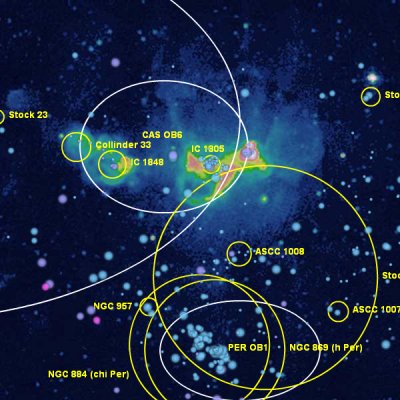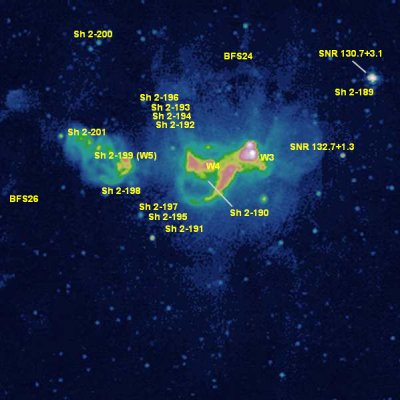
The great Heart and Soul star formation region, ionised by the Cas OB6 association, is most visible at radio frequencies. This image shows the major ionising stars, clusters and associations in this sector, including the Per OB1 association.
Source: Galactic Plane Explorer radio image
Gart Westerhout first observed the prominent radio sources W3, W4 and W5 in this sector in the 1950s. Amateur astronomers more poetically describe the area as "Heart and Soul" because of the dramatic appearance of the nebulae at visual frequencies. In particular, the HII regions associated with W3 and W4 look like a human heart and the HII regions surrounding W5 look like a fetus or newborn infant. Per OB1, one of the greatest OB associations known in the outer galaxy, lies to the south.
The Heart and Soul region is ionised by the Cas OB6 association and is one of the brightest parts of the Cassiopeia arc, which in turn is the brightest section of the Perseus arm visible from Earth.
Cas OB6 contains two visible ionising star clusters - IC 1848 and IC 1805.
IC 1805, embedded in the W4 molecular cloud, ionises the HII region Sh 2-190, the Heart nebula, and contains at least 10 O-class stars including three rare ultrahot stars: the O4 supergiant HD 15570, one of the most massive single stars known in the Milky Way, the O5 class HD 15629 and the massive O5 class multiple (possibly a triple) HD 15558. [1] Also present further east in Sh 2-190 is the microquasar LSI +61 303, which is believed to have been blown out of IC 1805 by a supernova explosion about 1.7 million years ago. [2] LSI +61 303 is a neutron star or black hole releasing a jet of material at 60% of the speed of light. [3]
W4 is part of a complex sequence of gas shells that stretch far above the galactic plane. [4]
The radio source W3 and HII region IC 1795 are located in a molecular cloud on the the heavily obscured western side of the Heart nebula. The best analysis of this region so far has used the Spitzer infrared space telescope and has found a Central Cluster that has formed a bubble driving a second generation of star formation in two other distinct clusters, W3 Main and W3(OH). [5]
IC 1848 ionises the Soul nebula (Sh 2-199) and is dominated by the multiple 06V star HD 17505. [6] HD 17505 contains 7 visual components, and spectroscopic analysis in ultraviolet reveals that the central star HD 17505A is itself made of three separate components. The core Aa1 and Aa2 binary stars orbit each other with a period of 8.571 days and these are in turn orbited by a third hotter and brighter Ab star with an uncertain period (but less than 61 years). [7] IC 1848 also contains two cooler O-class stars, HD 17520 (O9V) and HD 237019 (O8V). [8]

Most of the Heart and Soul sector nebulae (but not all) are prominent at radio frequencies.
Source: Galactic Plane Explorer radio image
Sh 2-201 is a tiny HII region that appears to float just to the northeast of the Soul nebula like a moon orbiting Jupiter. It lies at roughly the same distance as the Soul nebula and is ionised by a star cluster visible in infrared. [9]
Other smaller nebulae associated with Heart and Soul include Sh 2-192, Sh 2-193, Sh 2-194, Sh 2-196 and Sh 2-198. Russeil argues that Sh 2-192, Sh 2-193 and possibly Sh 2-196 belong to the same star formation region at about 2400 +/- 320 parsecs. [10] On the other hand, Avedisova and Palous link Sh 2-192 and Sh 2-194 at 2110 parsecs. [11] Sh 2-198 is ionised by the O 9.5 V star LS I +59 153 at 2300 +/- 300 parsecs according to Avedisova, or 2900 parsecs according to another estimate. [12] The Blaha/Humphreys catalog lists LS I +59 153 as a member of Cas OB6. [13]
Sh 2-191 and Sh 2-197 were mistakenly included in the Sharpless catalog and are, respectively, the galaxies Maffei 1 and Maffei 2. Sh 2-195 is located in the same direction as these galaxies but is apparently a Milky Way HII region. [14] However, little of significance appears in the scientific literature about Sh 2-195.
Sh 2-189 is the planetary nebula Abell 3 and appears to be located at about the same distance as the Heart and Soul complex. [15]
The Per OB1 association, which appears to be dominated by the famous Perseus double clusters h Per (NGC 869) and chi Per (NGC 884), lies south of Cas OB6. These 13-19 million year old clusters appear to lie at the same distance as the Heart and Soul region. [8], [16]. Cappa and Herbstmeier identify 15 O-stars [17] in this direction (including one O4 and three O5) and Kharchenko lists more than 60 B-stars of class B2 or hotter in NGC 869 alone. [8] The 6.9 million year old ionising star cluster NGC 957 also appears in a similar distance and direction as do the two newly discovered clusters ASCC 1007 and ASCC 1008. [8], [18] Assuming that these stars are indeed all part of the same association, Per OB1 stands out as one of the greatest known OB associations in the outer galaxy.
The Camelopardalis molecular cloud complex and the Cam OB1 association extend into this sector from the east and can be detected in the foreground of Heart and Soul at about 1000 parsecs. [19] Other objects that are located at a similar distance to the Camelopardalis clouds include the star clusters Stock 5 and Collinder 33 [8], the HII region BFS24 [20] and the planetary nebula Sh 2-200 (HDW 2). [20] The 53.7 million year old Stock 5 lies at a distance of 1100 parsecs and contains the ionising stars HD 12509 (B1III) and HD 12567 (B0.5III). [8] Collinder 33, located at a distance of 1000 parsecs, is far older at 229.0 million years, but nevertheless contains several young ionising stars, including HD 18326 (O7V), DM +60 606 (B0), and TYC 4048-934-1 (B1n). [8]
In the foreground of Per OB1 is the moderately old (147.9 million years) and close (380 parsecs) cluster Stock 2. [8] Stock 2 is part of the Gould Belt, the ring of bright stars through which our Sun is currently travelling. Stock 2 may contain HD 13022 (O9.5Ia), HD 14442 (O5.5) and many B-stars [8] however this field is a confusing one because it lies in front of the great Per OB1 association and most of these stars are more usually associated with Per OB1. [17]
There are two supernova remnants in this sector, both visible at radio frequencies. SNR 132.7+1.3 (HB3) appears to be part of the W3 complex and so must lie at the same distance. [21] SNR 130.7+3.1 is the remnant of a supernova observed by Chinese and Japanese astronomers in the year 1181 and contains the central pulsar PSR J0205+6449 [22]. It is located at a distance of about 3200 parsecs. [23]
Nebulae in this sector
Notes
1. ^ De Becker, M., Rauw, G., Manfroid, J., & Eenens, P. 2006, Astronomy and Astrophysics, Early-type stars in the young open cluster IC 1805. II. The probably single stars HD 15570 and HD 15629, and the massive binary/triple system HD 15558
2. ^ Mirabel, I. F., Rodrigues, I., & Liu, Q. Z. 2004, Astronomy and Astrophysics, A microquasar shot out from its birth place
3. ^ Massi, M., Ribó, M., Paredes, J. M., Garrington, S. T., Peracaula, M., & Martí, J. 2004, Astronomy and Astrophysics, Hints for a fast precessing relativistic radio jet in LS I +61<SUP>°</SUP>303
4. ^ Oey, M. S., Watson, Alan M., Kern, Katie, & Walth, Gregory L. 2005, Astronomical Journal, Hierarchical Triggering of Star Formation by Superbubbles in W3/W4
5. ^ Ruch, Gerald T., Jones, Terry J., Woodward, Charles E., Polomski, Elisha F., Gehrz, Robert D., & Megeath, S. T. 2007, Astrophysical Journal, Spitzer Observations of the Giant Molecular Cloud W3
6. ^ Thompson, M. A., White, G. J., Morgan, L. K., Miao, J., Fridlund, C. V. M., & Huldtgren-White, M. 2004, Astronomy and Astrophysics, Searching for signs of triggered star formation toward IC 1848
7. ^ Hillwig, Todd C., Gies, Douglas R., Bagnuolo, William G., Jr., Huang, Wenjin, McSwain, M. Virginia, & Wingert, David W. 2006, Astrophysical Journal, Binary and Multiple O-Type Stars in the Cassiopeia OB6 Association
8. ^ Kharchenko, N. V., Piskunov, A. E., Röser, S., Schilbach, E., & Scholz, R.-D. 2005, Astronomy and Astrophysics, Astrophysical parameters of Galactic open clusters
9. ^ Ojha, D. K., Ghosh, S. K., Kulkarni, V. K., Testi, L., Verma, R. P., & Vig, S. 2004, Astronomy and Astrophysics, A study of the Galactic star forming region IRAS 02593+6016/S 201 in infrared and radio wavelengths
10. ^ Russeil, D., Adami, C., & Georgelin, Y. M. 2007, Astronomy and Astrophysics, Revised distances of Northern HII regions
11. ^ Avedisova, V. S. & Palous, Jan 1989, Bulletin of the Astronomical Institutes of Czechoslovakia, Kinematics of star forming regions
12. ^ Pismis, Paris & Mampaso, Antonio 1991, Monthly Notices of the Royal Astronomical Society, Infrared studies of H II regions - The Sharpless regions S148, 184, 198, 206 and 269
13. ^ Humphreys, R. M. 1978, Astrophysical Journal Supplement Series, Studies of luminous stars in nearby galaxies. I. Supergiants and O stars in the Milky Way. and the unpublished catalogs available here.
14. ^ Maršálková, Pavla 1974, Astrophysics and Space Science, A comparaison catalogue of HII regions
15. ^ Maciel, W. J. 1984, Astronomy and Astrophysics Supplement Series, A catalogue of distances of planetary nebulae
16. ^ Capilla, G. & Fabregat, J. 2002, Astronomy and Astrophysics, CCD uvbybeta photometry of young open clusters. I. The double cluster h and chi Persei
17. ^ Cappa, C. E. & Herbstmeier, Uwe 2000, Astronomical Journal, A Search for Interstellar Bubbles surrounding Massive Stars in Perseus OB1
18. ^ Kharchenko, N. V., Piskunov, A. E., Röser, S., Schilbach, E., & Scholz, R.-D. 2005, Astronomy and Astrophysics, 109 new Galactic open clusters
19. ^ Digel, Seth W., Lyder, David A., Philbrick, Amy J., Puche, Daniel, & Thaddeus, Patrick 1996, Astrophysical Journal, A Large-Scale CO Survey toward W3, W4, and W5
20. ^ Russeil, D. 2003, Astronomy and Astrophysics, Star-forming complexes and the spiral structure of our Galaxy
21. ^ Koralesky, Barron, Frail, D. A., Goss, W. M., Claussen, M. J., & Green, A. J. 1998, Astronomical Journal, Shock-excited Maser Emission from Supernova Remnants: G32.8-0.1, G337.8-0.1, G346.6-0.2, and the HB 3/W3 Complex
22. ^ Murray, Stephen S., Slane, Patrick O., Seward, Fredrick D., Ransom, Scott M., & Gaensler, Bryan M. 2002, Astrophysical Journal, Discovery of X-Ray Pulsations from the Compact Central Source in the Supernova Remnant 3C 58
23. ^ Roberts, D. A., Goss, W. M., Kalberla, P. M. W., Herbstmeier, U., & Schwarz, U. J. 1993, Astronomy and Astrophysics, High Resolution HI Observations of 3C58











